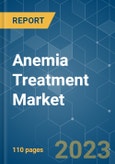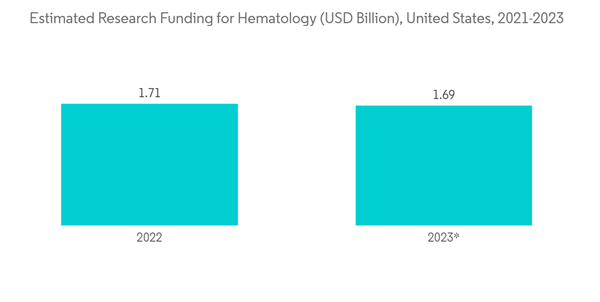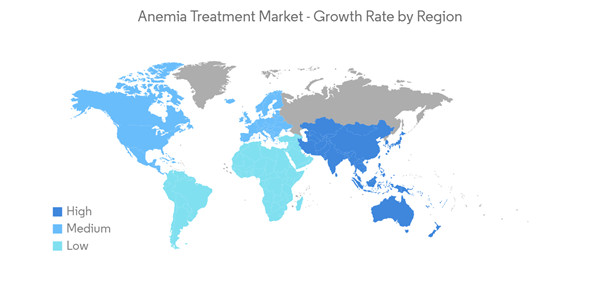Over the next few years, the anemia treatment market is expected to register a CAGR of 7.3%.
COVID-19 had an impact on the market's demand-supply balance as well as labor, raw material, and container shortages in addition to its health effects. The supply chain crisis impacted the healthcare industry, including the market for anemia treatment globally, due to inflation and constraints in the supply chain. However, in post-COVID-19 infection patients, the prevalence of anemia is estimated to be high. For instance, the study by Georgia State University in August 2022 evaluated the prevalence of anemia and reported that individuals diagnosed with diabetes, cancer, and anemia pre-COVID are at increased risk of post-COVID anemia. Additionally, the likelihood of post-COVID anemia was significantly higher in people who identified as black or African American, particularly in the outpatient (non-severe COVID-19) population. As a result, with a high prevalence of anemia following COVID-19 infection, there was expected to be a high demand for anemia treatment, which is expected to have a significant impact on the market over the forecast period.
The anemia treatment market is expected to witness robust growth over the forecast period, which is majorly attributed to the increasing cases of anemia across the globe, increasing pipelines for anemia drugs, and an increasing number of women of reproductive age. As per the National Family Health Survey, India, published in February 2022, the prevalence of anemia among six groups in 2021 was 25.0% in men (15-49 years) and 57.0% in women (15-49 years), 31.1% in adolescent boys (15-19 years), 59.1% in adolescent girls, 52.2% in pregnant women (15-49 years), and 67.1% in children (6-59 months). Hence, the survey revealed a high burden of anemia, which is expected to raise the demand for anemia treatment and drive the growth of the market over the study period.
Furthermore, studies for the effective treatment of anemia are still going on and are expected to get more approvals in the market and help the market grow. For instance, as per the JASN phase-3 study report in April 2022, Roxadustat effectively increased hemoglobin in patients with dialysis-dependent chronic kidney disease, with an adverse event profile comparable to that of epoetin alfa. Thus, the new studies reveal the efficacy and safety profile of various products used for anemia treatment and help the market grow over the forecast period. However, the lack of treatment awareness in developing regions, as well as the high cost of drugs, are expected to stifle the growth of the anemia treatment market.
Globally, the increasing prevalence of chronic kidney disease (CKD), inflammatory bowel disease (IBD), and cancer has increased the need for iron medication treatment of subsequent iron deficiency anemia (IDA), which is expected to drive market growth.For instance, as per the report by Kidney International Supplements in April 2022, it is anticipated that chronic kidney disease will eventually affect a greater number of people and become more significant among all of the other global causes of mortality. Hence, the rise in CKD in the population increases the risk of iron-deficiency anemia, a common complication of CKD, and likely increases the demand for anemia treatment that drives the market over the forecast period.
Furthermore, the approval and launch of novel formulations and strategic initiatives undertaken by key players to improve access to intravenous iron drugs are further expected to support market growth. For instance, in July 2021, Sandoz launched the generic version of Ferumoxytol, an intravenous medication used to treat iron deficiency anemia (IDA) in the United States. This launch carries out the plan to increase the portfolio of hospitals and clinics and give patients access to low-cost generic medications, which will boost the market over the forecast period.
Similarly, the presence of a strong key market player with a strong pipeline aids in market growth in the region. For instance, Global Blood Therapeutics, update 2022, in the United States has a strong pipeline in the different phases of clinical trials for sickle cell disease, such as inclacumab (phase III/IV), GBT021601 (phase I/II), HbF inducers, antisickling agents, inflammation, oxidative stress reduction, etc. Furthermore, in July 2022, Health Canada accepted for review the New Drug Submission (NDS) for GSK's daprodustat, an oral hypoxia-inducible factor prolyl hydroxylase inhibitor (HIF-PHI) for the potential treatment of patients with anemia of chronic kidney disease (CKD). Thus, the new product trials, approvals, and launches provide more efficient drugs with various applications in anemia that drive the market over the forecast period.
Furthermore, as the number of children born with sickle cell anemia rises in the United States, so will the demand for anemia treatment. According to a report by the NIH published in the August 2022 issue of the NCBI, sickle cell disease (SCD) is a multisystem disorder and the most common genetic disease in the United States, affecting 1 in 500 African Americans. Also, about 1 in 12 African Americans carries the autosomal recessive mutation, and approximately 300,000 infants are born with sickle cell anemia annually. Thus, the aforementioned factors together are expected to increase the demand for anemia treatment and favor the growth of the studied market in the region.
This product will be delivered within 2 business days.
COVID-19 had an impact on the market's demand-supply balance as well as labor, raw material, and container shortages in addition to its health effects. The supply chain crisis impacted the healthcare industry, including the market for anemia treatment globally, due to inflation and constraints in the supply chain. However, in post-COVID-19 infection patients, the prevalence of anemia is estimated to be high. For instance, the study by Georgia State University in August 2022 evaluated the prevalence of anemia and reported that individuals diagnosed with diabetes, cancer, and anemia pre-COVID are at increased risk of post-COVID anemia. Additionally, the likelihood of post-COVID anemia was significantly higher in people who identified as black or African American, particularly in the outpatient (non-severe COVID-19) population. As a result, with a high prevalence of anemia following COVID-19 infection, there was expected to be a high demand for anemia treatment, which is expected to have a significant impact on the market over the forecast period.
The anemia treatment market is expected to witness robust growth over the forecast period, which is majorly attributed to the increasing cases of anemia across the globe, increasing pipelines for anemia drugs, and an increasing number of women of reproductive age. As per the National Family Health Survey, India, published in February 2022, the prevalence of anemia among six groups in 2021 was 25.0% in men (15-49 years) and 57.0% in women (15-49 years), 31.1% in adolescent boys (15-19 years), 59.1% in adolescent girls, 52.2% in pregnant women (15-49 years), and 67.1% in children (6-59 months). Hence, the survey revealed a high burden of anemia, which is expected to raise the demand for anemia treatment and drive the growth of the market over the study period.
Furthermore, studies for the effective treatment of anemia are still going on and are expected to get more approvals in the market and help the market grow. For instance, as per the JASN phase-3 study report in April 2022, Roxadustat effectively increased hemoglobin in patients with dialysis-dependent chronic kidney disease, with an adverse event profile comparable to that of epoetin alfa. Thus, the new studies reveal the efficacy and safety profile of various products used for anemia treatment and help the market grow over the forecast period. However, the lack of treatment awareness in developing regions, as well as the high cost of drugs, are expected to stifle the growth of the anemia treatment market.
Anemia Treatment Market Trends
Iron Deficiency Anemia to Witness Healthy Growth Over the Forecast Period
Iron deficiency anemia is the most common type of anemia in which the blood does not have an adequate amount of red blood cells that carry oxygen to the body's tissues. As per the National Institute of Health, iron deficiency anemia is one of the main nutritional deficiency disorders affecting large fractions of the population, particularly such physiological groups as children, menstruating women, and pregnant women. There are a few medical conditions that cause iron-deficiency anemia, including kidney disease and long-lasting conditions that lead to inflammation like congestive heart failure or obesity.Globally, the increasing prevalence of chronic kidney disease (CKD), inflammatory bowel disease (IBD), and cancer has increased the need for iron medication treatment of subsequent iron deficiency anemia (IDA), which is expected to drive market growth.For instance, as per the report by Kidney International Supplements in April 2022, it is anticipated that chronic kidney disease will eventually affect a greater number of people and become more significant among all of the other global causes of mortality. Hence, the rise in CKD in the population increases the risk of iron-deficiency anemia, a common complication of CKD, and likely increases the demand for anemia treatment that drives the market over the forecast period.
Furthermore, the approval and launch of novel formulations and strategic initiatives undertaken by key players to improve access to intravenous iron drugs are further expected to support market growth. For instance, in July 2021, Sandoz launched the generic version of Ferumoxytol, an intravenous medication used to treat iron deficiency anemia (IDA) in the United States. This launch carries out the plan to increase the portfolio of hospitals and clinics and give patients access to low-cost generic medications, which will boost the market over the forecast period.
North America is Expected to Hold a Significant Share in the Market Over the Forecast Period
North America is expected to have a significant impact on the overall anemia treatment market, with the United States being the major contributor to the market. Anemia is one of the most common blood disorders in recent times. Some of the most common forms of anemia in North America are iron and vitamin deficiency, plastic, hemolytic, and sickle cell. According to the National Heart, Lung, and Blood Institute, the most prevalent blood condition is anemia, which affects more than 3 million Americans.Similarly, the presence of a strong key market player with a strong pipeline aids in market growth in the region. For instance, Global Blood Therapeutics, update 2022, in the United States has a strong pipeline in the different phases of clinical trials for sickle cell disease, such as inclacumab (phase III/IV), GBT021601 (phase I/II), HbF inducers, antisickling agents, inflammation, oxidative stress reduction, etc. Furthermore, in July 2022, Health Canada accepted for review the New Drug Submission (NDS) for GSK's daprodustat, an oral hypoxia-inducible factor prolyl hydroxylase inhibitor (HIF-PHI) for the potential treatment of patients with anemia of chronic kidney disease (CKD). Thus, the new product trials, approvals, and launches provide more efficient drugs with various applications in anemia that drive the market over the forecast period.
Furthermore, as the number of children born with sickle cell anemia rises in the United States, so will the demand for anemia treatment. According to a report by the NIH published in the August 2022 issue of the NCBI, sickle cell disease (SCD) is a multisystem disorder and the most common genetic disease in the United States, affecting 1 in 500 African Americans. Also, about 1 in 12 African Americans carries the autosomal recessive mutation, and approximately 300,000 infants are born with sickle cell anemia annually. Thus, the aforementioned factors together are expected to increase the demand for anemia treatment and favor the growth of the studied market in the region.
Anemia Treatment Market Competitor Analysis
With several companies present, the market for anemia treatment is competitive. Companies are focusing on developing drugs or therapies to treat anemia. Entry into this market is difficult as the company has to go through stringent regulations. The key players operating in this market are Akebia Therapeutics, Inc.; Bluebird Bio, Inc.; GSK plc; Pieris Pharmaceuticals, Inc.; Sanofi; Takeda Pharmaceutical Company Limited; AbbVie, Inc. (Allergan Plc); Pharmacosmos A/S; Pfizer, Inc. (Global Blood Therapeutics, Inc.); and Covis Pharma GmbH (AMAG Pharmaceuticals, Inc.).Additional benefits of purchasing the report:
- The market estimate (ME) sheet in Excel format
- 3 months of analyst support
This product will be delivered within 2 business days.
Table of Contents
1 INTRODUCTION
4 MARKET DYNAMICS
5 MARKET SEGMENTATION (Market Size by Value - USD million)
6 COMPETITIVE LANDSCAPE
Companies Mentioned (Partial List)
A selection of companies mentioned in this report includes, but is not limited to:
- Akebia Therapeutics, Inc.
- Bluebird Bio, Inc.
- GSK plc
- Pfizer Inc. (Global Blood Therapeutics, Inc.)
- Pieris Pharmaceuticals, Inc.
- Sanofi
- Takeda Pharmaceutical Company Limited
- AbbVie Inc. (Allergan Plc)
- Pharmacosmos A/S
- Covis Pharma GmbH (AMAG Pharmaceuticals, Inc.)
Methodology

LOADING...










